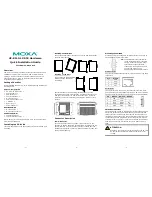
29
Maintenance
Product Manual - Liquid Cylinders
Loss of Vacuum
The loss of vacuum on a liquid cylinder is usually associated
with excessive cylinder frosting or rapid pressure rise.
Excessive pressure rise, however, can be normal. A new
liquid cylinder or one that has not been used recently is
considered to have a warm inner vessel Warm cylinders
will build pressure fast after filling and vent off the excess.
A liquid cylinder that has been filled and not used will build
pressure and vent the excess off. The higher the pressure was
in the storage tank at the time of filling, the faster the liquid
cylinder will vent off
Excessive pressure rise can also be an indication of vacuum
loss The Dura-Cyl
®
/Cryo-Cyl
®
Liquid Cylinders are
equipped with a pump-out plug that is expelled from the
pump-out body if there is a loss of vacuum. This indicates an
inner vessel leak. The pump-out body and plug are covered
by a black plastic cap to protect them from the environment
and tampering. If it is determined that the pump-out plug is
properly seated in the pump-out body, but a loss of vacuum
is still suspected, an evaporative loss rate test should be
performed.
Vented Evaporation Loss Test
The vented evaporation loss test should be used on liquid
cylinders that are in nitrogen, oxygen or argon service. It
should be done over a period of three to four days.
1
Fill the container to the half full mark using the same
product the container previously contained.
2
Verify that the pressure building, gas use, and liquid
withdrawal valves are all closed
3
Allow container to vent for approximately 24 hours.
4
Weigh the container as accurately as possible.
5
Allow the container to continue venting for an
additional 48 hours
6
Weigh the container as accurately as possible.
7
Calculate the difference between the two weights
obtained in steps 4 and 6. A weight loss of more than
16 pounds (7.3 kg) in 48 hours is considered excessive;
contact your local Chart distributor or the factory for
appropriate disposition.
8
If the weight loss is not excessive, proceed with
pressurized evaporation loss test.
Pressurized Evaporation Loss Test
The pressurized evaporation loss test should be used on
liquid cylinders that passed the vented loss test or are in CO
2
or N
2
O service It will take longer than a vented test since
pressure must rise by evaporation only.
1
Pressurize the unit to 50 psig (3.4 barg) and check for
any plumbing leaks.
2
Vent and then fill the unit with its designated service
product. Maintain pressure in the liquid cylinder while
filling. Do not vent after filling.
3
Verify that all valves are tightly closed
4
Observe pressure rise to relief valve setting (this could
take up to six days for a typical cylinder).
5
Once the unit is at relief valve pressure, weigh it as
accurately as possible.
6
Check weight a second time after 24 hours
7
Calculate the difference between the two weights
obtained in steps 5 and 6. A weight loss of more than
10 pounds (4.5 kg) in 24 hours is considered excessive;
contact your local Chart distributor or the factory for
appropriate disposition.
8
If the weight loss is not excessive, the liquid cylinder is
considered to have the proper vacuum level.
Follow the troubleshooting guide on the next page and
the repair procedures found later in this section. If there
are any other questions, contact Chart’s Technical Service
Department at: 1-800-400-4683.
Содержание Cryo-Cyl80HP
Страница 2: ......
Страница 6: ......
Страница 12: ......
Страница 32: ......
Страница 50: ...44 Specifications Product Manual Liquid Cylinders MCR Plumbing Configuration...
Страница 52: ...46 Specifications Product Manual Liquid Cylinders LCCM Plumbing Configuration...
Страница 54: ......
Страница 56: ......
Страница 57: ...51 Product Manual Liquid Cylinders Appendix 1 Troubleshooting Guides Cutaway Explanation...
Страница 62: ...56 Appendix 1 Product Manual Liquid Cylinders Troubleshooting Flow Chart 3...
















































